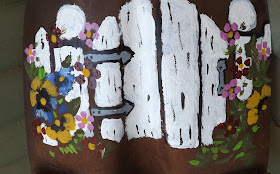a couple of shovels...........
old and broken shovels........that is.
This shovel once belonged to my husband's grandfather.It has long since lost it's shaft and has a little of the wood left on the handle.
and a little of the wood shaft still in the shovel back. Although it is large heavy metal, the edges of the shovel are showing signs of wear. I think the white coloring is old cement that someone never washed off after using the shovel.
I could not stand the fact that it was just lying in a pile of unusable things..........so I decided to give it another life.
I love the way the old cement makes the shovel look , along with the rust. Instead of painting over the whole shovel, I simply gave it a good cleaning with a hard bristle brush.............
I then decided to paint the word "welcome" onto it along with a humming bird and some flowers.
with a few more flowers on the upper edge.
(click onto photo for a better view)
Even though I just painted this...........it looks as if it was painted years ago.........
don't you think?
Now it sits by the old milk can.............
to welcome guests at our back door.
I placed the shovel handle on top of the old milk can.
The other shovel was also lying in the pile..........
is not so old, but very broken and very rusted.
After cleaning the rust........the shovel had the prettiest natural background color. I painted a white garden gate with flowers on each side.
I then added the words "my garden" with a buzzing bee.
The wooden shaft was broken with just the right amount of wood
left to stick into my garden ground. Now it is the perfect sign for my garden.
Do you have any broken tools just lying around waiting for you to re-purpose?
Have you painted them or done something else with them?
I would love to hear!





























